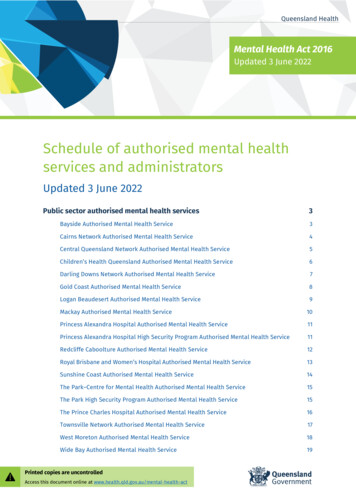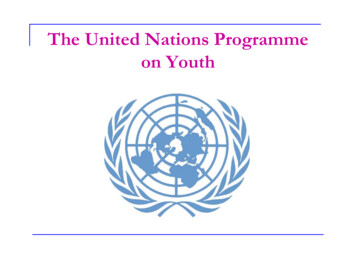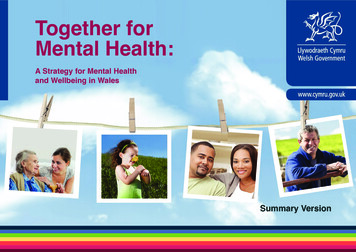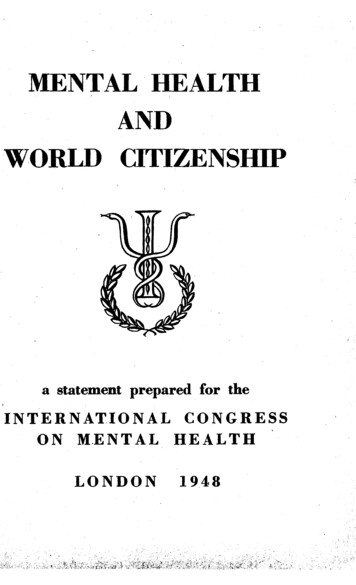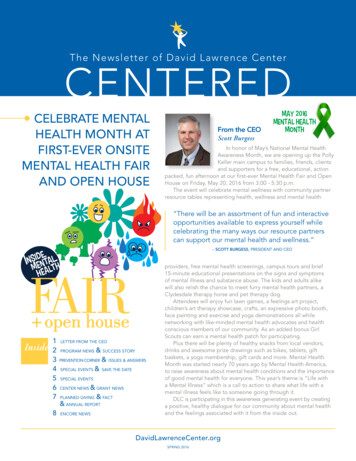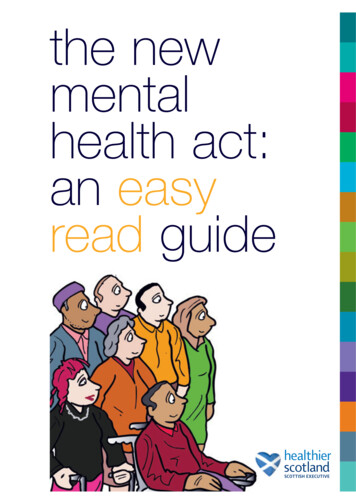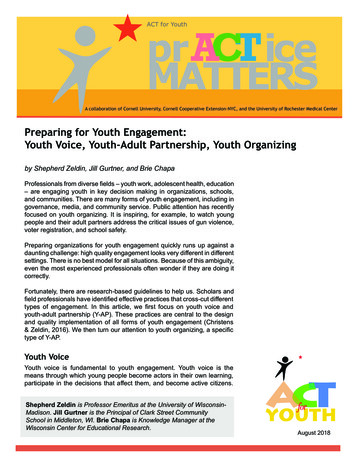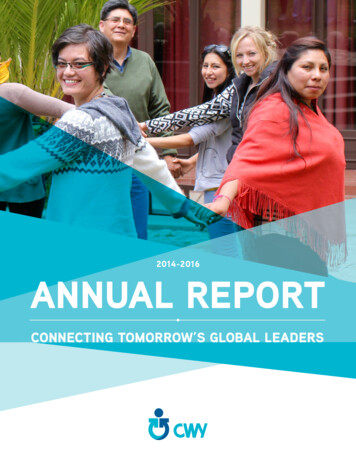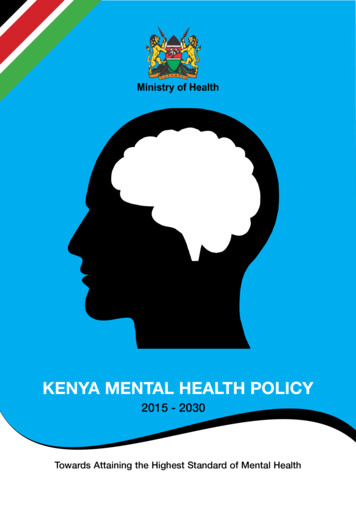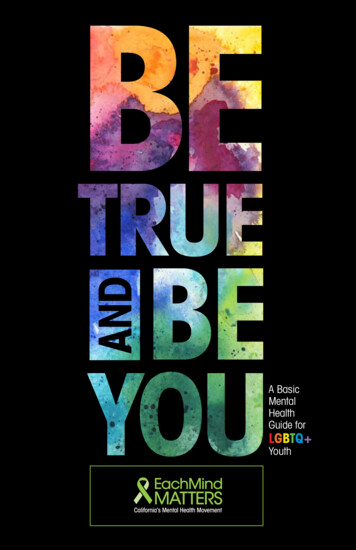
Transcription
A BasicMentalHealthGuide forLGBTQ Youth
If you are, or think you might be LGBTQ (Lesbian, Gay, Bisexual,Transgender, Queer, Questioning, and other identities), and goingthrough a tough time, you’re not alone. Whether you’re trying to figureout your own identity or want to learn how to talk to others, it can behard to know where to find support. The stigma and discriminationLGBTQ individuals may face from family, friends and society canincrease risk for mental health challenges. However, it is importantto remember that we are all unique and being LGBTQ doesn’tnecessarily increase our risk for mental health issues. As an LGBTQ young person, there are certain stressors you may face from peoplewho do not accept your orientation or gender identity. These pagesdon’t have all the answers; in fact, this is just the beginning—a basicguide for how to talk and think about sexual orientation, genderidentity/expression, and mental health, someways to cope with stress and emotions, and howto get support for yourself and others.Let’s start with defining the terms we use todescribe the concepts of sexual orientation andgender identity/expression. Since words meandifferent things to different people, it’s importantto have some common understanding beforeentering into a deeper discussion.23
“I identify as transgender, more specifically gender fluid andgenderqueer Above all, I always feel that my spirit is of a genderthat is neither male nor female, and being born in a femalehuman body, it is not possible to have a body that matches thegender in which I spiritually exist.”– First, Do No Harm: Reducing Disparities for Lesbian, Gay, Bisexual,Transgender, Queer, and Questioning Populations in California (2012)2SEXUAL ORIENTATIONGENDER IDENTITY & EXPRESSIONSexual orientation refers to who we are attracted to emotionally, physically,and romantically. Sexual orientation is sometimes referred to simply as"orientation" to emphasize that your orientation is not just about sexualattraction, but encompasses a combination of romantic, emotional, and/orphysical attraction that manifests differently for everyone. We will use theterms sexual orientation and orientation interchangeably in this booklet.How you sense yourself inside as a man, a woman, a blend of both,something in-between, or any other way, is what we call “gender identity.”Your gender identity can be the same or different than the sex you wereassigned at birth (the sex that’s listed on your birth certificate). Gender isalso not binary—meaning there are more than two genders and peoplemay use many terms to describe their gender identity. Terms you may haveheard are transgender, genderqueer, intersex, agender, bigender, gendernonconforming, gender expansive, gender fluid, two-spirit or cisgender.Like with orientation, these terms are constantly evolving, and each personshould choose the words that feel most appropriate and authentic to them.People whose gender identity is different from their sex assigned at birthmay want to change their name, pronouns, and/or physical appearanceto better match how they feel inside. Some people also choose to usehormones and/or have surgery to help change their appearance. Somepeople may choose not to, or may not be able to make these changes. Ifthis is something you’re interested in doing, it’s important to find a medicalprovider experienced in transgender healthcare. Like orientation, genderidentity is self-defined and very personal. Your gender identity is notsomething that someone else can decide for you. Although seeking supportfrom friends and providers can be helpful, only you can determine how bestto describe the way you understand and experience your own gender.Sexual orientation may not be obvious in the way one speaks, acts, ordresses. There are over a hundred terms people have used to describe theirorientation. Some terms you may have heard are: gay, lesbian, bisexual,pansexual, sexually-fluid, queer, asexual, two-spirit, same-gender-loving,or straight. These terms are constantly changing and evolving, and eachperson should choose (or create!) the words that feel most authentic tothem. Orientation is self-defined and very personal; you get to decidewhat words fit you best, and what they mean to you. Research shows thatorientation is not something that you can change,1 nor can anyone elsedecide your orientation for you. How you define and label your orientationmay be different from how your peers, family members, friends, or otherpeople define theirs, and that’s okay.“Our symptoms are not black-and-white, and everyone shouldhave equal understanding and validation for our troubles.”– Anonymous, Rainbow Community Center of Contra Costa County14Just the Facts Coalition. (2008). Just the facts about sexual orientation and youth: A primer for principals,educators, and school personnel. Washington, DC: American Psychological Association. Retrieved html.Mikalson, P., Pardo, S., & Green, J. (2012) First, do no harm: Reducing disparities for lesbian, gay,bisexual, transgender, queer and questioning populations in California. Sacramento, CA: Mental HealthAmerica of Northern California and Equality California Institute.In addition to gender identity, everyone has their own gender expression.While gender identity is your internal sense of self, gender expression refersto the ways you communicate your gender to the outside world. This caninclude your behavior, clothing, haircut, makeup, voice, body characteristics,etc. Some people have a more fluid gender expression, and may presentdifferently day-to-day, while others have a more consistent genderexpression. Gender expression does not always match up with genderidentity, and that's okay. Only you can decide what gender expressionmakes you feel most comfortable and genuinely yourself.2Retrieved April 25, 2017, from 08f39ae12e0d4b.pdf5
COMING OUTComing out can be an empowering process for many LGBTQ youthwhen they are ready to share their sexual orientation and/or gender identitywith others. Some youth choose to disclose multiple identities, one of theiridentities, or none of their identities to their friends, family, and community.The coming out process looks different for every individual. Some peoplechoose not to come out for various reasons, including personal safety, fearof rejection by family or other loved ones, or to avoid being subjected tostigma and discrimination around their identity. The decision to come out ornot come out is deeply personal, and is different for everyone.If you think you are ready to come out, there are some things that canhelp ensure that it is a positive – and even empowering – experience. First,consider your emotional and physical safety when choosing who to tell.Look for allies, or individuals who have shown that they support and affirmLGBTQ people. If you want to come out to one person or a small group ofpeople, make clear that it is your right, not theirs, to share your orientationor gender identity with others. When you are ready, choose safe, affirmingpeople to share youridentity with, andconsider how and whenLooking for more information aboutyou want to come outsexual orientation and genderto them. There is noidentity? Check out these support“right” order or processresources:for who you choose totell, and just becauseEach Mind Matters Fact Sheetsyou tell some peopleat ReachOut.comdoesn’t mean you needBeing LGBTQ:to tell others. In fact, ifus.reachout.com/facts/lgbtqyou are financially orComing Out:otherwise ton your family andunsure if they will beThe Trevor Projectsupportive, this mayTrevor Lifeline: 866-488-7386be a consideration inwww.thetrevorproject.orgdeciding when and howto tell them.Trans Lifeline877-565-8860LGBT National Youth Talkline1-800-246-PRIDE (7743)www.glnh.org6LGBTQ ANDMENTAL HEALTHWhat is mental health? According to MentalHealth.gov, “mental healthincludes our emotional, psychological, and social well-being. It affects howwe think, feel, and act. It also helps determine how we handle stress, relateto others, and make choices. Mental health is important at every stage oflife, from childhood and adolescence through adulthood.”3Simply being LGBTQ does not mean you will automatically experiencemental health challenges. However, as an LGBTQ young person, thereare certain stressors you may face from people who do not accept yourorientation or gender identity. These may include: stigma and discrimination;homophobia/biphobia/transphobia; rejecting behaviors from friends, family,or religious community; and bullying, harassment, hate speech, or violence.These experiences can be traumatic and hurtful, and stressors like thesecan affect your mental health and wellbeing.The stressors you may experience are also affected by the intersection ofother parts of your identity, such as your race/ethnicity, social class, culture,religion, age, disability, and more. Being subject to stressors and othertraumatic experiences can contribute to mental health challenges. But thereis hope too: If you find yourself struggling with a mental health challenge,support and treatment is available and effective. In fact, 70-90% of peoplewho seek help for mental health challenges report decreased symptomsand improved quality of life.4 Most people with mental health challenges getbetter, and many recover completely.3What Is Mental Health? (2013, March 12). Retrieved February 21, 2017, ntal-health/4http://www.nami.org/7
How do you know if you should reach out for support?Everyone experiences mental health challenges differently. Below, we discusssome of the signs and symptoms of common mental health challenges.Depression is a common mental health challenge that includes deepfeelings of sadness, apathy, and hopelessness that may not go away ontheir own. Depression can change the way you think, feel, and act, and canmake your body feel sick as well. It’s possible to feel depressed even if yourlife looks good “on the surface.” Feelings of depression can make it difficultto work, go to school, or participate in other important areas of your life.Anxiety is a feeling of fear that makes you feel uncomfortable and scared.Anxiety is a normal emotion that can help you deal with stressful situations,but some people feel anxious very often or very strongly. Anxiety can makesituations feel much worse than they are. Strong, sudden feelings of fearand anxiety are called “panic attacks.” In addition to strong feelings of fearor worry, anxiety and panic attacks can include physiological symptomssuch as restlessness, irritability, insomnia, racing thoughts, and poorconcentration. Anxiety can make it difficult to keep up with everyday tasksand responsibilities.Trauma or PTSD (Post-Traumatic Stress Disorder) can happen if you seeor live through something very frightening or hurtful. It’s normal to feel afraidsometimes, but those with PTSD or trauma-related mental health challengesmay continue to feel scared for a long time after the event is over. Even ifthey are now very safe, the fear and danger can continue to feel quite real.Trauma can have long-lasting effects that may not go away on their own,and can affect everyday functioning.Self-harm is a way of coping that causes a person to physically harm theirbody. People who practice self-harm often share that it is their attempt toexperience temporary relief from painful feelings or situations. However,there are healthier ways to release painful feelings and to deal with toughsituations. For specific ideas see “What You Can Do” in the section below,or visit ReachOut.com for strategies to stop or cope with te-self-harmEating disorders may cause people to harm or exert control over theirbodies as a way of dealing with tough situations or painful feelings. An eatingdisorder can exist when a person’s thoughts and behaviors become overlyfocused on food and/or body weight. Three of the most common eatingdisorders are anorexia, bulimia and extreme overeating or binging.Being healthy means more than the absence of illness; mental health meanshaving positive, helpful ways to deal with your emotions, thoughts andfeelings. Your coping strategies help you to deal with the stressors you faceon a daily basis, and are important in managing your overall wellness. Oneway to learn about and practice healthier coping strategies is with the help ofa supportive mental health professional.Talking to a mental health professional can help you understand yourfeelings and identify healthy ways to process your emotions. While onlya trained physician or mental health professional can diagnose a mentalillness, there are many tools you can use on your own to help you feelbetter or stay well. If you’re experiencing difficulties managing these or otherchallenges in your life, consider seeking help.These descriptions include signs of some common mental healthchallenges; however, symptoms can manifest differently for each individual.If you are, or think you may be experiencing mental health challenges, helpis available. See the last page of this booklet for a list of recommendedresources.Everyone does their best to deal with difficult emotions and situations. Whenfaced with stress, trauma or mental health challenges, some people turn toless healthy coping strategies such as using drugs or alcohol, self-harm, orunsafe sexual behavior to help manage difficult feelings.89
“There are so many people out there struggling with the same mentalillness that we are. It is so important to reach out. If you're hurting,ask for help. If you can’t find it, there’s resources out there, I guaranteeit. And there’s people out there who are gonna relate, who are gonnawant to help you any way they can. Even when it feels like no onewould want to, or you feel like you don’t deserve that help, it’s outthere. And it’s meant just for you.”– Alexandra, EMM StoryWHAT YOUCAN DOTAKING CARE OF YOURSELFPracticing self-care is a vital part of getting and staying well. Finding ahealthy way to care for yourself can be as simple as talking to a friend,spending some time outside, going to the doctor, having a good cry,listening to music, getting adequate sleep, cooking, exercising, or practicinga creative hobby. Spending time with loved ones may make you feel better,or you may need to take some time for yourself. However you need to takecare of yourself, make yourself a priority. If you want to learn more about selfcare for wellness, check out the Wellness Recovery Action Plan movementat www.mentalhealthrecovery.com.SUPPORTIVE RELATIONSHIPSOpening up to someone you trust about what’s on your mind can be ahealthy and important way to get support. Allies can be good sources ofsupport, and can listen to you and remind you that you’re not alone. Thinkof someone you trust and feel safe around, who has expressed love andacceptance in the past. If you’re having trouble getting up the courage to saysomething, try writing a note or email or sending a text to let them know thatyou need a helping hand. If you don’t feel comfortable talking to friends orfamily members, a trusted counselor, teacher, or youth leader may be ableto offer support. You can also look for LGBTQ support groups, either at alocal LGBTQ center, or in your school.Sadly, it’s possible that some people in your life may respond negativelyinstead of offering support. According to a 2012 survey, 26% of LGBTQ youth say that one of their biggest problems is not feeling accepted by theirfamily.5 Some LGBTQ youth don’t feel safe or supported in their home orat school, and may experience emotional or physical abuse from family andpeers. If you are facing situations like this, remember that you never haveto feel alone and that help is available to you. You can take steps to find thesupport you need, including: Talking to a trained counselor at The Trevor Project (1-866-488-7386 orthetrevorproject.org). If you feel unable to stay or return home, services like the NationalRunaway Safeline (1-800-RUNAWAY or www.1800runaway.org) can helpyou find the resources and support you need to stay safe.510Growing up LGBT in America (Rep.). (2012). Retrieved February 24, 2017, from Human Rights Campaignwebsite: http://www.hrc.org/youth-report/about-the-survey11
Is my relationship healthy?How do I know if I’m in an abusive relationship?Everyone has the right to a safe and healthy relationship – one that isbased on mutual honesty, trust, respect and open communication.Remember that both people should always feel like an equal inthe relationship and feel free to speak their mind. Disagreementsare normal in a relationship, but how you choose to resolve yourdisagreements is what really counts. At the end of the day you shouldfeel happy and safe in your relationship.Teen dating abuse is a deliberate and escalating pattern of abuse inwhich one partner in a significant or intimate relationship attemptsto exercise power and maintain control over the other partner. Theabusive person may use many different actions and behaviors suchas threats of or actual use of verbal, emotional, physical, sexualabuse, or online abuse to control the victim.You know your relationship is probably healthy if your partner: Respects your gender pronouns and chosen name. Respects your boundaries. Gives you space to hang out with friends and family withoutthinking you’re cheating. Doesn’t take your money or tell you what to buy. Never threatens to out you to people. Never tells you you’re not a real lesbian, gay man, trans person, etc.“A common thread among LGBTQ peopleis loneliness and fear that drives themaway from social contact with otherpeople. It makes us pull back from thething that heals us—which is being incontact with others.” – First, Do No Harm:Reducing Disparities for Lesbian, Gay, Bisexual,Transgender, Queer, and Questioning Populationsin California (2012)When the abuse is physical or sexual, it may be easier to recognize.Emotional abuse is much harder to recognize but no less damaging.Relationship violence often starts as emotional or verbal abuse andcan quickly escalate into physical or sexual violence.My Relationship is Unhealthy or Abusive,What Can I Do?Abusive partners may say that disrespectful or violent behavior inan LGBTQ relationship is normal, but it’s not. LGBTQ youth oftenexperience dating and relationship abuse in much the same waysas heterosexual youth. However, lack of social support for theirrelationships is an added stress for LGBTQ youth. You can faceunique obstacles in identifying abuse and seeking help.The National Domestic Violence Hotline has highly trainedadvocates who can talk confidentially with anyone experiencingrelationship violence, seeking resources or information, orquestioning unhealthy aspects of their relationship. The Love isRespect hotline is available 24/7 by calling 1-866-331-9474 orthrough online chat at loveisrespect.org. You can call, text orchat with someone, and the website offers LGBTQ affirmativeinformation and resources. If you’re in an unhealthy or abusiverelationship, you have many options – including obtaining arestraining order and/or meeting with a counselor. Whether or notyou’re ready to end the relationship, there is help available for you.This content was provided by CatalystDomestic Violence Services of Butte County.1213
WHERE TO FIND MORE SUPPORTMENTAL HEALTH SERVICESEverybody has the right to be safe at school, home and work. You do nothave to accept violence, threats, harassment, bullying or hateful speech.We all experience varying levels of mental health throughout our lives. In fact,half of U.S. adults will experience some type of mental health challenge overtheir lifetime.6 Sometimes these challenges can become more serious andrequire more attention. However, recovery is also common and many formsof help are available.No matter what you’re going through, it can be helpful to talk to a supportivefriend, family member, school counselor, doctor or other person whom youtrust. If you don’t have anybody to talk to, there are online communities andlocal organizations you can reach out to for help. Asking for help does notmean you are weak; in fact, it’s a very brave step. Please see the back ofthis booklet for more resources and specific places to find support.“My recovery fromdepression helpedme realize I could live a full life asa gay man without shame. It waslike a huge weight was lifted offmy shoulders”Different approaches work for different people: for some talk therapy istheir tool of choice, for others it may be medication, LGBTQ youth supportgroups, or a self-directed tool such as a “WRAP” plan (short for WellnessRecovery Action Planning). If you choose to seek counseling, a mentalhealth professional can help you sort through your challenges and choicesso that you know what is available and can decide what works best for you.YOUR RIGHTSWhile some young people find their parents or guardians to be a sourceof support when they are struggling, others may experience rejection ornegative consequences for sharing their orientation, gender identity, ormental health challenges. What can you do if you need support, and don’tfeel safe asking your parents or guardians for consent to see a mentalhealth therapist? California has laws (Health and Safety Code § 124260and Family Code § 6924) which allow minors age 12-17 to receive mentalhealth services without their parent’s or guardian’s consent. Your privacyis also protected, and in the majority of cases the therapist cannotshare information.For more information about your rights in California:www.teenhealthlaw.org– Excerpt from “Harry’s or more information about California law:www.tinyurl.com/glmc5hqFor legal information and assistance:www.transgenderlawcenter.org614Fact Sheet, CDC Report: Mental Health Surveillance Among Adults in the United States. (2011). RetrievedFebruary 24, 2017, from https://www.cdc.gov/mentalhealthsurveillance/fact sheet.html15
HOW TO FIND MENTAL HEALTH SUPPORTWorking with a mental health professional is a type of relationship; and, likeall relationships, finding the right person can take time and often takes morethan one try. If the first professional you meet doesn’t work for you, don’tgive up – keep trying until you find the right match.The good news is that there are some things you can do to increase yourchances of finding the right person. Keep in mind that, in the end, you arethe expert on you. Trust your feelings when selecting a helper or a type oftreatment. Below are a few tips to try: Don’t be afraid to ask the counselor if they have experience working withyouth from your cultural background (such as race, ethnicity, religion, etc.)who have the same orientation or gender identity as you, or working withyouth who are questioning their sexual orientation or gender identity. Check to see if your insurance network has therapists that specializein working with LGBTQ people and/or young adults. Some providerswill allow you to search for mental health professionals that specialize inworking with specific populations. Search online for LGBTQ -friendly therapists in your area. Call your local LGBTQ community center or organization forrecommendations. Your friends or other people you trust may also knowthe names of good therapists in your area.In addition to finding a therapist who specializes in working with youth andLGBTQ people, it’s a good idea to ask a few questions during the phoneinterview or first meeting, such as:16 What experience do you have workingwith the types of problems I amexperiencing? What is your approach to doing therapyin a situation such as this one? How much experience do you havetreating LGBTQ people? What if I disagree with or questionsomething you tell me?“(My experiences) really droveme to seek help – professionalhelp, mental health – becauseI know that there’s really noway that I could just resolveit on my own. I’m trying tofind out: how do I deal withall these things? I had apsychotherapist who is Latinoand he’s gay. Working withhim, it really helped me tounderstand that I can neverput limitations on myself, thatthere are a lot of possibilities.I feel really thankful thatI was able to work withpsychotherapists that weregay-affirming.”– Dennis, EMM Story17
REPARATIVE OR CONVERSION THERAPYAFFORDING THERAPYNot all types of therapy are helpful, safe, or legal. “Reparative therapy” or“conversion therapy” are terms that refer to any therapy or effort that tries tochange someone’s orientation or gender identity or expression. You mightalso hear it called by other names such as “ex-gay therapy.” These types ofefforts have been proven by research to not only be ineffective, but harmful.The cost of therapy shouldn’t be a barrier to reaching out for help. Manytypes of insurance, including MediCal, offer coverage for mental healthservices. In addition, there are community-based clinics that may offer freetreatment, health care clinics on school/college campuses with free mentalhealth services, and private practitioners who offer free or “sliding-scale”fees that are adjusted according to your ability to pay.California has outlawed reparative or conversion therapies for anyone underthe age of 18. If you are 18 or older, you also have the right to refuse servicesfrom any therapist who tries to change your orientation, gender identity orexpression. For more information, visit ative-therapy“I was introverted and deeply depressed,I had virtually no friends at my schooland the only other queer people I knewwere in movies. I felt so alone, like noone could ever understand. I rememberwhen I first came to the [RainbowCommunity Center]. I felt like I hadfinally found a place.”Here are a few places to look for affordable mental health care: Call 2-1-1 or go to 211.org for a referral to community mental healthcenters in your area The Substance Abuse and Mental Health Services Administration(SAMHSA) offers an online locator for mental health and substanceabuse treatment facilities nationally. ndtreatment.samhsa.gov/locator The Network of Care (www.networkofcare.org) offers a directory of mentalhealth and substance use services in California. Mental Health America has a network of affiliate organizations that mayoffer community-based services: http://www.mentalhealthamerica.net/find-affiliate If you have an LGBTQ center in your community, they may also havesupport groups, services, or information available to help you find servicesin your area.– C.K., Rainbow Community Centerof Contra Costa County1819
GET HELP NOWIf you are thinking about suicide, you deserveimmediate help—please call the Trevor Lifeline at866-488-7386. Counselors who are trained to help LGBTQ youth are available to talk 7 days a week, 24 hours a day. Youcan also call the Trans Lifeline at 877-565-8860.If it’s not safe for you to be heard talking to a crisis worker, youcan reach out for help via text at the Crisis Text Line: TextHOME to 741-741The Trevor Project also has text and chat options atthetrevorproject.org, and you can get peer support by joiningTrevorSpace at www.trevorspace.org/login.The National Suicide Prevention Lifeline is also available for support(free, confidential): 800-273-TALK (8255)If urgent medical attention is required, call 9-1-1 or go to theemergency room of the nearest hospital.20If you’re worried about someone else:1.Don’t be afraid to reach out to the person you care about andcreate a safe space for them to talk about what they’re goingthrough.2. Talk to the person openly and directly about suicide. It’s okayto ask someone “Are you thinking about suicide?” To learnmore about what to say, visit the “Find the Words” section atwww.SuicideIsPreventable.org3. Don’t leave the person alone.4. Find a trusted adult to help you. Saving someone’s life is nota betrayal.If you see one or more of the three critical warning signs below,especially if the behavior is new, increased, or seems related toa painful event, loss or change, seek help by calling the NationalSuicide Prevention Lifeline or the Trevor Lifeline right away. Talking about death or suicide Seeking methods for self-harm, such as searching online orobtaining a gun Talking about feeling hopeless or having no reason to live21
JOIN THE MOVEMENT›EACH MIND MATTERSWe all have mental health, and our voices are amplified when we speakup together. California’s Mental Health Movement grows strongerevery day as millions of people and thousands of organizations areworking to advance mental health. There are many ways to add yourvoice and strengthen the movement.SPEAK UPWe believe in healing through action, strength through diversity, and powerthrough collaboration. Everyone deserves the opportunity to live a healthy,happy and productive life. People experiencing mental health challenges canand do get better. By talking openly and honestly about mental health, wecan help make that happen.SPREAD THE WORDEach Mind Matters (EMM) is gaining momentum every day as people joinCalifornia’s Mental Health Movement. Together we can create supportivecommunities where no one feels alone.Every person plays an important role in helping people feel comfortableby having open conversations and encouraging those who need it to seeksupport. Below are some things you can do to help.To learn more about what EMM does or find ways to get involved in yourcommunity, visit www.eachmindmatters.org.SHARE THE FACTS ABOUT MENTAL HEALTHShare these facts and more by downloading the Each Mind Matters MentalHealth Support Guide to distribute to friends, family and colleagues atwww.eachmindmatters.org/wp-content/uploads/20
Anxiety is a feeling of fear that makes you feel uncomfortable and scared. Anxiety is a normal emotion that can help you deal with stressful situations, but some people feel anxious very often or very strongly. Anxiety can make situations feel much worse than they are. Strong, sudden feelings of fear and anxiety are called "panic attacks."

